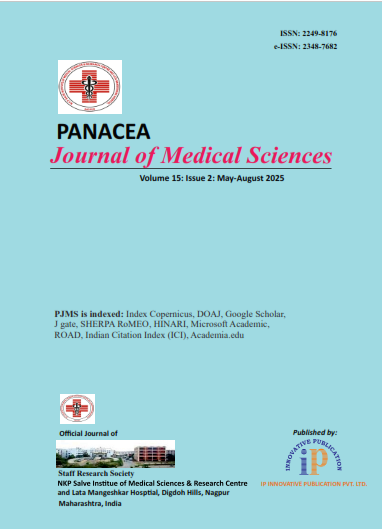Panacea Journal of Medical Sciences
Panacea Journal of Medical Sciences (PJMS) open access, peer-reviewed triannually journal publishing since 2011 and is published under auspices of the “NKP Salve Institute of Medical Sciences and Research Centre”. With the aim of faster and better dissemination of knowledge, we will be publishing the article ‘Ahead of Print’ immediately on acceptance. In addition, the journal would allow free access (Open Access) to its contents, which is likely to attract more readers and citations to articles published in PJMS.Manuscripts must be prepared in accordance with “Uniform requiremen...

Expression of telocytes in cardiovascular diseases
Page: 443-449
Background: Telocytes are recently discovered cells that reprogram the terminally differentiated cardiomyocytes to re-enter the cell cycle. Their activity is also altered in atherosclerotic blood vessels. Telocytes express CD117/c-kit. This study focuses on the significance of changes in the expression of telocytes in the heart and the coronary arteries in various diseases.
Materials and Methods: This is a retrospective study. Histopathology of post-mortem examination (PME) of adult and foetal hearts between March 2021 and March 2023 were reviewed. Sections from normal and diseased heart and coronary arteries were selected for immunohistochemistry with CD117/c-kit to highlight telocytes. Telocytes were counted.
Results: 62 heart (46 adult and 16 foetal) specimens were examined. All foetal and 11 normal adult hearts showed 5 and 3 telocytes per 10 fields respectively. Recent myocardial infarction (MI) seen in 10 cases showed 10 telocytes per 10 fields in the peri-infarction zone while 8 cases of old scars showed only 1 telocyte per 10 fields. Cardiac hypertrophy was seen in 22 cases. Telocytes were seen in 6 cases only, showing 1 telocytes per 10 fields. 92 coronary arteries were examined. 27 arteries were normal with 4 telocytes per 10 fields. 33 arteries showed marked atherosclerosis with 14 telocytes per 10 fields.
Conclusion: An increase in telocytes signifies their stem cell-like activity. In recent MI cases increased telocytes suggest the likelihood of cardiac tissue regeneration after an MI. In cardiac hypertrophy, telocytes increase during a continued stimulus of increased workload, however, the timing of the biopsy plays a significant role. In older lesions with no ongoing stimulus for telocytes, there is no increase observed. In atherosclerosis, telocytes are altered causing vessel wall changes. Modulation of telocytes is a novel step that may change the management of cardiovascular diseases.
Article Metrics
- Visibility 16 Views
- Downloads 4 Views
- DOI 10.18231/pjms.v.15.i.2.443-449
-
CrossMark
- Citation
- Received Date April 26, 2024
- Accepted Date October 28, 2024
- Publication Date August 19, 2025